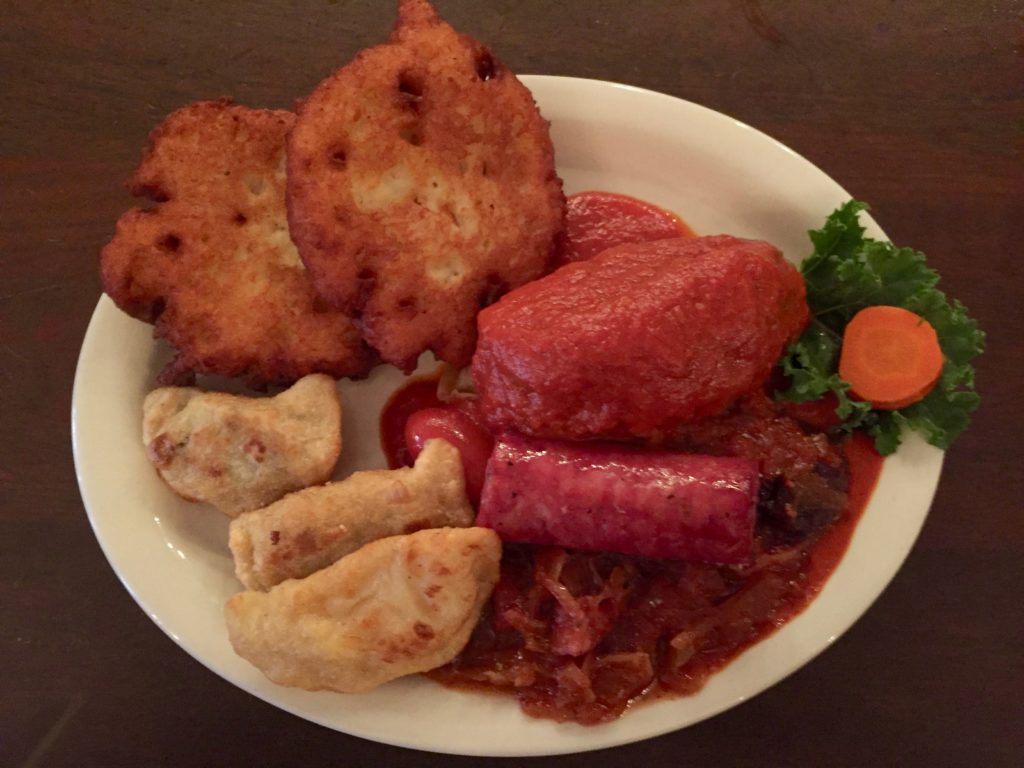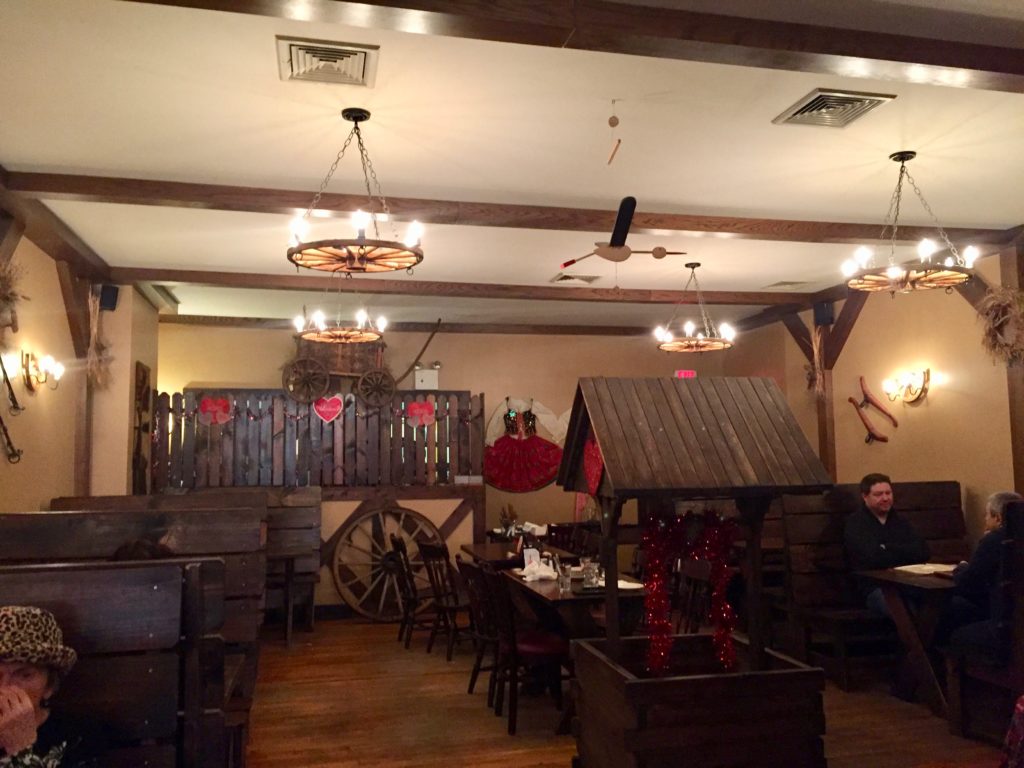
The plate of Polish specialties – three pierogis, two potato pancakes, polish kielbasa, hunter’s stew and stuffed cabbage. Photo: Lisa Kocay.
By Lisa Kocay
The landscape inside Karczma is not Brooklyn but a farm somewhere in Poland: lanterns hang from the ceiling, farming tools grace the walls, hay accents appear throughout and Polish folk music plays in the background. A woman in a white peasant blouse under a black dress embellished with red flowers welcomes customers for the traditional Polish village cuisine that has made Karczma a Greenpoint staple for almost 10 years.
Slawek Letowski, one of the Karczma’s three owners, emigrated from Poland in 1989, when he was 22 years old, on vacation with his then-girlfriend, who didn’t want to return to Poland. He stayed because he likes the energy and international aspects of the city.
He worked as a painter and at other jobs before spending eight years at a wholesale wine and liquor company. When it closed in 2007, Letowski was without a job. He had been delivering wine to restaurants, and spoke to the owner of the restaurant formerly located where Karczma is now. She was ready to sell her place, so Letowski, along with his wife, Urszula Letowski, and her brother, Krzysztof Drzewiecki, took over the lease and opened Karczma.
Karczma is the generic name for a tavern in Poland, Letowski said, where it connotes a combination of a restaurant, bar and inn. He serves pierogis, which are dumplings filled with potato or meat, along with stuffed cabbage, kielbasa, potato pancakes and other Polish food. The restaurant seats about 80 people and is busiest, he says, on weekends.
Although Greenpoint is a historically Polish neighborhood, the population has shrunk by almost half since 2000, when Voices of New York reported that there were 13,660 Polish residents. By 2010, that number had fallen to 7,873. Many one-time Polish residents, including Letowski, moved to Queens in search of cheaper rent.
Letowski said that the costs of doing business – rent, food costs, labor and taxes – are on the rise as well, eating into his restaurant’s profits. A commercial space about the size of Karczma used to cost between $4,000 and $5,000 in Greenpoint, but now it’s $15,000 to $20,000. He is currently negotiating a new lease for Karczma, and suspects his rent will increase, which will mean higher menu prices.
“Somebody has to pay for the rent,” he said.
Theo Eastwind moved to New York from Austria in 1995 and has been eating at Karczma since it opened. A broker at Capri Jet Reality Corporation, he said that Greenpoint is experiencing the kind of development that redefined Williamsburg, an adjacent and more expensive neighborhood that has become a tourist destination.
“That’s a byproduct of gentrification,” he said.
Magda Bar, a 29-year-old Polish émigré who moved to Greenpoint five years ago, works at Polonia Bookstore, near Karczma. The exodus of Polish residents has been bad for business because there are fewer clients for the Polish establishments, she said. And as Polish businesses close, the community becomes less tight-knit.
Bar says that she hasn’t felt the effects of the shrinking community personally, but her parents live in New York; she might feel differently if she didn’t have them nearby. The remaining Polish stores in Greenpoint provide her with a sense of familiarity – though she confesses that the local restaurant food isn’t as good as the food she remembers eating at home.
The community gathers instead at Polish churches and at Karczma, though those customers are now part of a more diverse mix. Alexandra Kozlowska, a Polish immigrant who has been a server at Karczma for two years, said there’s been an increase in other nationalities, as well as what she calls “yuppies,” young Americans with a hip lifestyle. Polish food seems to be enjoying a surge in popularity: Her friend told her it’s “fancy” to drink Polish beer and eat pierogis.
Martyna Kowalski, who moved here from Poland 14 years ago and has worked at Karczma for eight years, said that if she were homesick she would move from Queens to Greenpoint, because the neighborhood is still sprinkled with Polish influence. She enjoys working at Karczma because of the relationships she has established with coworkers.
Three waitresses, each one slender and blonde, stand at the bar and speak to each other in Polish, their mannerisms similar to three close friends gossiping. Their outfits, traditional Polish attire, were purchased in Poland, and the head chef is a Polish immigrant, Letowski said.
Letowski said Karczma reminds him of being home in Poland, which helps when he’s homesick. He misses his family and hometown, but he returns every few years.
Karczma has proven to be a success, but Letowski said he wouldn’t recommend that his 12-year-old son, who sometimes hangs out at Karczma, go into the restaurant industry because he isn’t optimistic about the future of restaurants in New York City.
“It’s up to him, but I think the work is very hard, so I probably would not recommend it,” he said. “It’s not an easy lifestyle, and with the real estate prices getting sky high, it’s going to be significantly less money than ever in the future unless you’re a big corporation.”
Tags: gentrification, greenpoint, karczma, pierogis, Polish

Your Comments